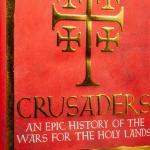Crusaders, Dan Jones
As the name might suggest, Dan Jones’s most recent book, Crusaders, is about the Crusades. But this most recent instalment to the canon of crusading history goes a step beyond what many similar books do, to tell a ‘people’s history’ of the Crusades – all of them – from the middle of the eleventh century through to the end of the fifteenth. It looks at the Crusades from all angles – Muslim as well as Christian, Latin as well as Byzantine, female as well as male – and covers Europe and the Near East, including the ‘holy wars’ against the pagan peoples of eastern Europe, against the Cathars in France, and against Jews in Germany. Its scope is, therefore, no less than encyclopaedic in aim.
The approach used to cover such a vast swathe of history is more microscopic than encyclopaedic, and the better for it. With so much history to choose from, Jones has taken the route of the personal, focusing on particular larger-than-life characters to tell the story through their eyes. And these characters aren’t always the most obvious. Thus, Richard the Lionheart and Saladin warrant at most a few pages in the narrativeA story; in the writing of history it usually describes an approach that favours story over analysis.A story; in the writing of history it usually describes an approach that favours story over analysis. of the Third CrusadeThe Third Crusade (1189-1192) was an attempt by European leaders to reconquer the Holy Land from Saladin.The Third Crusade (1189-1192) was an attempt by European leaders to reconquer the Holy LandLands comprising of what is now Isreal and Palestine, including the holy land of the Jewish, Christian and Islamic religions. from Saladin.; instead, we learn of Margaret of Beverley, a pilgrim from Yorkshire who ends up defending the holy city of Jerusalem with a saucepan on her head. Venice’s story of the Fourth Crusade is told through that of Enrico Dandolo, the city’s blind, and aged, doge, and the only person ever to be buried in Hagia Sophia. The book is full of these characters – including Roger of Sicily, who really did fart in his advisers’ general direction – bursting from the pages to tell a story – their story – in a way that has not been done before, reminding the reader that there is more to history than ‘great men’. Perhaps some people will be disappointed by this approach, but there are plenty of alternatives on the market to satisfy them and, let’s face it, far more of us who would prefer to gain new perspectives on what could otherwise be old hat.
A more legitimate complaint is one born of necessity: with so much ground to cover, Crusaders can’t help but be a whistle-stop tour. The details of historiographical discourse, the blow-by-blow accounts of each crusade, their multitude of causes and consequences, can never hope to be covered in just one volume, and nor does Jones try. Crusaders can only ever be an introduction to a topic so massive that it has had gallons of ink spilt on it in the last decade alone. This might leave the more knowledgeable reader feeling somewhat underwhelmed, and even the novice can feel there are a few too many loose ends. But as Jones writes in the introduction, the book is designed to inspire the reader ‘to delve deeper into the history of crusading’, to make them ask questions rather than necessarily supplying the answers. P. 5.
P. 5.
His use of sources helps this: although the modern greats of crusading history are mentioned with thanks in the introduction, Jones clearly states that he is using only primary sources for direct quotations – a refreshing change from many narrative histories currently available on the market. And these primary sources, despite their diversity, are in the main available to the average reader: generally, they are printed and available in translation. Once again, this could lead the pedantic to criticise, and I have seen plenty of excellent books knocked for their authors’ apparent unwillingness to venture into the archives. But again, I would question whether archival research is necessary in a book such as this. It doesn’t pretend to be an academic monograph, and nor should it. Instead, it is an exceptionally well-written – and relevant – rip-roaring tour through the Crusades and a wonderfully colourful introduction to the people who lived through them, fought in them, ran away from them, and made them happen. As such, I can’t recommend Crusaders enough.
- Log in to post comments







